Southwest Pacific Ocean Circulation and Climate Experiment (SPICE)
SPICE is an endorsed project of WCRP/CLIVAR
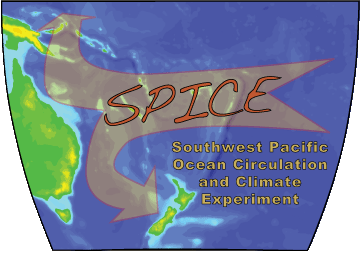
|
Principal Investigators: |
Rationale
Climate in the South West Pacific region varies due to superimposed effects of El Niño/Southern Oscillation (ENSO) and other signals including seasonal variations, global warming and natural decadal-scale variability. Ocean transport changes, driven by basin-scale winds, are the principal cause of temperature and salinity variability. Theory, numerical simulations and the few existing large-scale observational datasets suggest a complex regional ocean circulation: While surface flow is eastward as far north as 15°S, occurring partly as concentrated filaments emerging from the East Australia Current (EAC) recirculation, at thermocline level and below the South Equatorial Current (SEC) transports more than 30 Sv westward. Encountering the southwest Pacific islands, the SEC divides into strong and narrow zonal jets that cross the Coral Sea and bifurcate at the east coast of Australia, feeding both the EAC and the New Guinea Coastal Current system. The latter supplies most of the water of the Equatorial Undercurrent, and emerges finally as the east Pacific cold tongue. Variations of both transport and water properties propagate into the flow of both current systems and their eddies and can influence the modulation of the ENSO cycle, which then reverberates through the climate of the entire basin. Though variability of this circulation has profound consequences for both regional and basin-scale climate, the structure of its currents and the mechanisms that cause its variations remain poorly sampled. The broad-scale observational network (Argo, VOS XBT sampling, and satellite winds and altimetry) is beginning to provide a large-scale picture, but the complex island jets and western boundary currents require dedicated study.
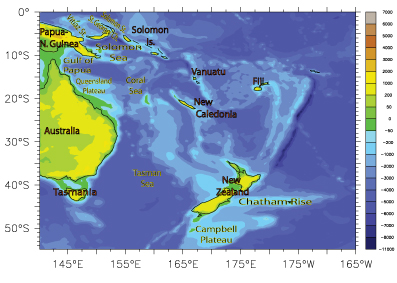 |
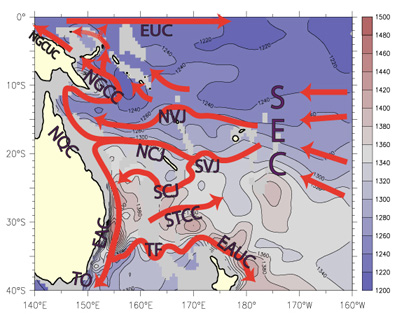 |
Objectives
The goal of SPICE is to observe, model and understand the role of the Southwest Pacific ocean circulation in:
- the large-scale, low- frequency modulation of climate from the Tasman Sea to the equator, and
- the generation of local climate signatures whose diagnosis will aid regional sustainable development.
This goal will be realized through four specific efforts, developped in the scientific background document.
- Analysis of the southwest Pacific role in global coupled models;
- Development of an observational program to survey air-sea fluxes and currents in the Coral, Solomon and Tasman Seas, and their inflows and outflows, with special attention to the strong boundary currents and jets;
- Combination of these observations with focused modeling efforts to devise a sustained monitoring program to adequately sample the time-variability of the currents and their heat and mass transports;
- Using remotely- and locally-sampled meteorological fields, and the ocean analysis, determination of the air-sea heat and freshwater fluxes and water mass transformations that occur in the region, and their effects on the local and global climate. A focus here may be the design of a process study to observe, model and understand the South Pacific Convergence Zone.
The simultaneous large-scale and regional approach allows applications ranging from ENSO forecast improvement, to coral bleaching, cyclone trajectory or prediction of local ocean and climate conditions. The proposed methods and organization to address the SPICE objectives are described in the implementation plan (October 2008).
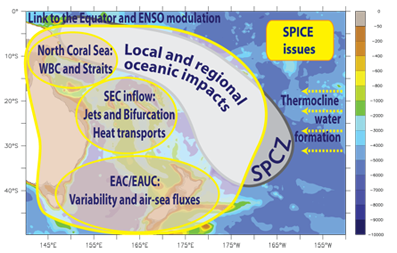 |
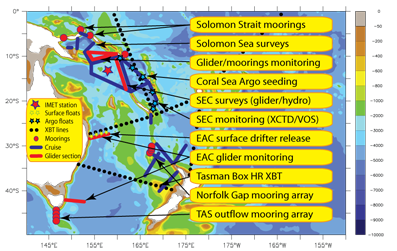 |
Related Programmes
Solomon Sea and Coral Sea Oceanography (Solwara)
SPICE Data and Information Page
IMOS Bluewater, GBR and NSW Nodes
Events
Dec. 2010: AGU Fall Meeting-San Francisco: OS34: Ocean Circulation Variability and Air-Sea Interactions in the Western Tropical Pacific, organized by C. Maes, B. Qiu and K. Ando
Oct. 2010: CLIVAR PP meeting; SPICE update, A. Ganachaud
Feb. 2010: Ocean Science 2010: Special session on "Western Tropical Pacific: Capturing and Understanding its Variability". SPICE early results and future plans, S. Cravatte (invited). SPICE presentation
Oct. 2009: OceanObs09: CLIVAR Pacific Panel Observational Programs side meeting: Progress from SPICE C. Maes (invited). SPICE presentation
Feb. 2009: International Conference on Southern Hemisphere Meteorology and Oceanography, Melbourne AUS. SPICE presentation
Jul. 2008: Western Pacific Geophysics Meeting, Cairns AUS. SPICE poster.
Dec. 2007: Fall-AGU session on "Dynamics of the Southwest Pacific Ocean and the South Pacific Convergence Zone (SPCZ)" OS8. SPICE poster ; discussion Report
Nov. 2007: CLIVAR Pacific Panel / ENSO Workshop, Guangzhou, CHINA: SPICE presentation
Sept 14th 2007: SPICE presentation (pdf) at the CLIVAR SSG meeting in Geneva
Sept. 2006, Honiara (Solomon Islands), presentation by L. Gourdeau at SOPAC Science, Technology and Resources Network (STAR) meeting.
Feb. 2006, Hawaii, presentation by L. Gourdeau at CLIVAR Pacific Panel meeting
Oct. 2005, Concepcion, Chile presentation by A. Ganachaud at the CLIVAR/OOPS/GOOS/Argo/CPPS workshop on the South Pacific
Aug. 2005, a dedicated workshop was held to initiate this project in Cairns, Australia, to review ongoing work and identify possibilities for advancement (proceedings). This workshop provided the bases for the design of a coordinated observational and modelling program under the auspices of CLIVAR. This resulted in the publication of a first SPICE prospective document.
Publications
|
Ganachaud A., G. Brassington, W. Kessler, C. R. Mechoso, S. Wijffels, K.Ridgway, W. Cai, N. Holbrook, P. Sutton, M. Bowen, B. Qiu, A. Timmermann, D. Roemmich, J. Sprintall, D. Neelin, B. Lintner, H. Diamond, S. Cravatte, L. Gourdeau, P. Eastwood and T. Aung., 2008. Southwest Pacific Ocean Circulation and Climate Experiment. Part II. Implementation Plan. NOAA OAR Special Report / International CLIVAR Project Office, CLIVAR Publication Series No. 133 Ganachaud, A., W. Kessler, S. Wijffels, K.Ridgway, W. Cai, N. Holbrook, M. Bowen, P. Sutton, B. Qiu, A. Timmermann, D. Roemmich, J. Sprintall, S. Cravatte, L. Gourdeau, and T. Aung., 2007. Southwest Pacific Ocean Circulation and Climate Experiment. Part I. Scientific Background. NOAA OAR Special Report / International CLIVAR Project Office, CLIVAR Publication Series No. 111 Ganachaud, A., S. Cravatte, L. Gourdeau, K. Ridgway, W. Cai, W. Kessler, M. Williams, D. Roemmich, J. Sprintall and B. Qiu. Conception of a Southwest Pacific Ocean Circulation and Climate Experiment. Noumea : IRD, 2006. (Sciences de la Mer. Oceanographie Physique. Rapports de Convention, No 8), 21 pp. Ganachaud, A., L. Gourdeau, W. Kessler, and K. Ridgway. Proceedings of the workshop of the Southwest Pacific Ocean Circulation and its relation with climate, Cairns, aout 2005. Noumea : IRD, 2006. (Sciences de la Mer. Oceanographie Physique. Rapports Scientifiques et Techniques, No 5), 23 pp. |
For more information please contact: Alexandre (Alex) Ganachaud













